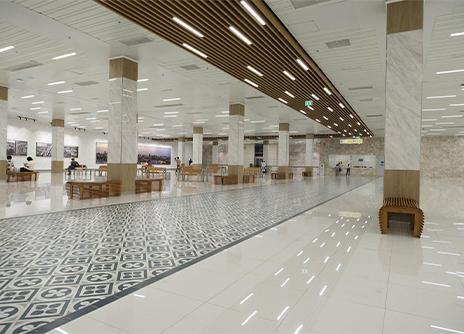
October 28, 2025
Confused between the denser, tougher vitrified tiles and the decorative finishes of ceramic tiles? Do you want all-out durability, or a warmer look with texture and pattern? Most houses work best with a combination—vitrified floor tiles for high-use and outdoor areas, ceramic floor tiles for more relaxed indoor rooms.
What's the big difference?
How they're manufactured
Ceramic tiles: natural materials and clay, fired in a kiln, typically glazed.
Vitrified tiles: clay combined with other minerals, fired at a higher temperature to create a denser, tougher body.
Porosity & stains
Vitrified tiles are very low on porosity and hold up much better to stains than ordinary ceramic tiles.
Ceramic tiles are more porous, so efficient clean-ups and good grouting are important.
Surface feel
Vitrified tiles sometimes have coarser textures that are less slippery to walk upon.
Ceramic tiles tend to be smooth or glossy; therefore select matte or anti-skid finishes for bathrooms and kitchens.
Where they function best (Indian home setting)
Lounge, corridor, busy kitchen
Select vitrified floor tiles. They take scrapes, spills, and frequent cleaning in their stride.
Bedrooms, study, guest room
Select ceramic floor tiles for diversity, pattern, and a softer look at a friendly price.
Bathrooms & utility rooms
Both will do. Vitrified makes it easier to control stains; textured ceramic can be more secure underfoot.
Balcony, patio, entrance (outdoor)
Ceramic tiles are feasible outdoors, but they don't compare with vitrified for extreme conditions. They don't absorb extreme temperature fluctuations or heavy usage as well. For more rugged outdoor usage, use heavy-duty vitrified tiles such as Somany Durastone—constructed for toughness, strength, and longevity.
Durability & daily use
Imagine furniture pushed to clean underneath it, school bags pulled along floors, or a fallen steel spoon.
Ceramic tiles are robust for everyday use but chip upon sharp impact.
Vitrified tiles are denser and resist abrasion and knocks over the years.
Do you want a floor that endures harsh use, or one that comes in a variety of colours and patterns but requires extra cleaning? It totally depends on how you want your home to look like.
Water, stains & cleaning
Spills occur—tea, curry, hard water.
Vitrified tiles: extremely non-porous; stains are less likely to bond. Sweep and mop, and you're done.
Ceramic tiles: glaze assists, but body absorbs more; clean spills immediately and keep grout.
Dislike cleaning stains? Lean vitrified in kitchens, bathrooms, and dining rooms.
Looks, sizes & layout
Ceramic tiles like Venza provide expressive patterns, colours, and craft textures—ideal for feature walls and cosy rooms.
Vitrified tiles such as Techstone Olive are available in big formats and stone, marble, or concrete appearances with closed joints for a serene, contemporary look.
Safety underfoot
Vitrified tiles usually have natural grip because of their rough textures.
Ceramic tiles may be glossy or smooth; use matte or structured anti-skid for balconies and wet areas.
Budget & installation
Ceramic tiles: generally lower initial cost and simpler cutting—convenient for borders and speedy makeovers.
Vitrified tiles: higher cost and more difficult cutting, but less maintenance and longer lifespan in high-traffic or wet areas.
Are you optimizing for the first bill, or for overall cost over ten years?
Quick choice
Opt for ceramic tiles / ceramic floor tiles if you desire:
Decorative finishes and warm, textured appearances indoors
Value for low-to-moderate traffic spaces
Additional underfoot grip from more naturally coarser surfaces
Opt for vitrified tiles / vitrified floor tiles if you desire:
Maximum wear resistance for living rooms, corridors, and high-traffic kitchens
Robust water and stain resistance with easy maintenance
Outdoor-ready performance—pick Somany Durastone for balconies, terraces, and entrances
Conclusion
You don’t need a single “winner.” Use both, by application: vitrified tiles where strength and stain resistance matter most; ceramic tiles where design choice and comfort lead. Prefer low-fuss cleaning and outdoor durability? Go vitrified—think Somany Durastone for heavy-duty areas. Want pattern, warmth, and budget control? Pick decorative ceramic floor tiles. With Somany Ceramics, the decisions are simple—personality indoors with ceramic, hard-working performance with vitrified. Choose room by room, and rest easy.